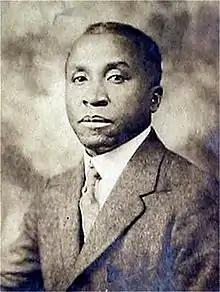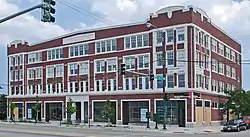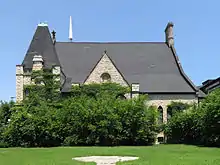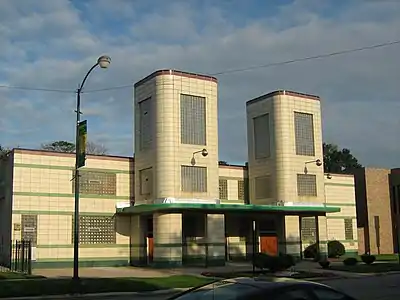Walter T. Bailey
Walter Thomas Bailey (January 11, 1882 – February 21, 1941) was an American architect from Kewanee, Illinois. He was the first African American graduate with a bachelor of science degree in architectural engineering from the University of Illinois at Urbana-Champaign and the first licensed African-American architect in the state of Illinois. He worked at the Tuskegee Institute, and practiced in both Memphis and Chicago. Walter T. Bailey became the second African American that graduated from the University of Illinois.[1]
Walter T. Bailey | |
|---|---|
 | |
| Born | January 11, 1882 |
| Died | February 21, 1941 (aged 59) |
| Nationality | American |
| Occupation | Architect |
| Buildings | Woodmen of Union Bath House First Church of Deliverance |
Early life and education
Walter Thomas Bailey was born January 11, 1882 in Kewanee, Illinois, where he attended Kewanee High School.[2] He enrolled at the University of Illinois at Urbana-Champaign in 1900.[3] Bailey was the first African-American graduate of the University of Illinois' School of Architecture with a Bachelor of Science in architectural engineering.[4] He earned that degree in 1904 and was granted an honorary master's degree in architecture from the university in 1910.[3] On October 15th 1905 Walter T. Bailey married Josephine L. McCurdy. In the same year, Josephine gave birth to their first born, Edith Hazel. Seven years later they gave birth to their second child, Edith Hazel in 1913.[5]
Architectural career
Bailey was the first licensed African-American architect in the state of Illinois.[6] Initially, after he graduated, Bailey worked for a small architectural firm owned by Henry Eckland in his hometown of Kewanee.[3] During this time he also worked for a Champaign, Illinois firm, Spencer & Temple.[3] Bailey assisted in the planning of the 1905 Colonel Wolfe School in Champaign during this period.[3]
In 1905 Bailey was appointed as the head of the Mechanical Industries Department at the Tuskegee Institute.[3] While at Tuskegee, Bailey designed several campus buildings including White Hall (1908), and a girl's dormitory.[3] He remained at Tuskegee until 1916 when he moved to Memphis and opened a practice on Beale Street. After Bailey's move to Memphis he began the first of multiple commissions for the Knights of Pythias. He designed the Mosaic State Temple Building and the Pythian Theater Building, both in Little Rock in 1922. The next year he undertook another Arkansas commission, this one in Hot Springs, the Pythian Bath House and Sanitarium.[3] The Pythian Bath House and Sanitarium was constructed solely for the use of African Americans.[7]

Through his Knights of Pythias connections Bailey was given what would be the largest commission of his career, the National Knights of Pythias Temple in Chicago, Illinois. Construction began on the building in 1924 and Bailey moved his office to the city.[2] The construction of National Pythian Temple cost $850,000.[8]The site of the temple was on Chicago's south side in an area known as "Bronzeville" or "Black Metropolis".[3] Bailey first rented an office on the second floor of the Overton Hygienic Building on South State Street.[2][9] Construction on the National Knights of Pythias Temple proceeded slowly and by 1928 the interior of the building remained unfinished.[2] The National Pythian Temple "was planned to be the headquarters of the Knights of Pythias and to house the lodge's combined national offices, numerous meeting halls, and rent-producing stores and offices."[5] Walter T. Bailey designed terra- cotta griffins in the frieze of the Knights of Pythias Temple.[10] Though the Knights of Pythias eventually lost ownership of the building, Bailey did maintain his office in the structure after its completion.[2] The Knights of Pythias Temple was demolished in 1980.[10]
Aside from the Knights of Pythias Temple in Chicago Bailey had few major commissions during the 1920s and the subsequent Great Depression greatly decreased business for Bailey and many other black entrepreneurs in the area.[2] The last major project for Bailey was the Chicago Landmark art moderne First Church of Deliverance in 1939.[2] The First Church of Deliverance designed in Art Moderne style, was inspired by Reverend Clarence H. Cobbs. The art Moderne style is predominately composed of strong horizontals with large glass panel windows. Walter T. Bailey implemented the style of Art Moderne by adding lines of green terra-cotta blocks on the facade of the Church of Deliverance.[11] The building served as both a church and a radio station for Reverend Clarance Cobbs to broadcast sermons.[5]
Death


Walter T. Bailey died on February 21, 1941 from pneumonia and complications caused by heart disease. Obituatries at the time stated he was working on two projects when he died. One was the Olivet Baptist Church, the other was reportedly the Ida B. Wells Homes but that work was probably in a secondary capacity.[2]
Selected works
- 1905 – Colonel Wolfe School, Champaign, Illinois
- 1906 – Alabama Agricultural Fair Negro Building, Montgomery, Alabama
- 1922 – Mosaic State Temple Building, Little Rock, Arkansas
- 1922–1923 – Pythian Theater Building, Little Rock, Arkansas
- 1923 – Pythian Bath House and Sanitarium, Hot Springs, Arkansas
- 1924 – Fraternal Savings and Trust Bank, Memphis, Tennessee
- 1924 – Knights of Pythias Building, Nashville, Tennessee
- 1924 – Woodmen of Union Bath House, Hot Springs, Arkansas
- 1924–1928 – National Knights of Pythias Temple, Chicago, Illinois
- 1928 – Momence Country Club, Momence, Illinois (plans only)
- 1929 – Mt. Moriah Lodge No. 28 Free and Accepted Masons, Evanston, Illinois
- 1939 – First Church of Deliverance, Chicago, Illinois
- 1940 – Ida B. Wells Homes, Chicago, Illinois
- 1941 – Olivet Baptist Church, Chicago, Illinois
References
- Williamson, Joy Ann (2003). "The Snail-like Progress of Racial Desegregation at the University of Illinois". The Journal of Blacks in Higher Education (42): 116–120. doi:10.2307/3592457. ISSN 1077-3711. JSTOR 3592457.
- Wilson, Dreck Spurlock. African-American Architects: A Biographical Dictionary (1865–1945), (Google Books link), Taylor & Francis, 2004, pp. 15–26, (ISBN 0415929598).
- "Walter T. Bailey 1904 MSAE, "Alumni", University of Illinois Urbana Champaign African American Architecture Alumni Project, updated 2008, accessed November 29, 2010.
- Mitchell, Melissa Research Project Spotlights African-American Architects from U. of I.", University of Illinois News Bureau, February 9, 2006, accessed November 29, 2010.
- Wilson, Dreck Spurlock (2004). African American Architects A Biographical Dictionary, 1865-1945. doi:10.4324/9780203493120. ISBN 9780203493120.
- Bey, Lee. "Art Moderne beauty: First Church of Deliverance", WBEZ, 91.5, February 15, 2010, accessed November 29, 2010.
- Anthony, Kathryn; Watkins, Nicholas (2009). A Legacy of Firsts: African Americans in Architecture at the University of Illinois at Urbana- Champaign (PDF). University of Illinois Press. p. 284. ISBN 9780252076657. Retrieved March 28, 2019.
- REED, CHRISTOPHER ROBERT (2011). The Rise of Chicago's Black Metropolis, 1920-1929. University of Illinois Press. doi:10.5406/j.ctt1xcdxg.6 (inactive January 11, 2021). ISBN 9780252036231. JSTOR 10.5406/j.ctt1xcdxg.CS1 maint: DOI inactive as of January 2021 (link)
- Savage, Beth L. and National Register of Historic Places. African-American Historic Places, (Google Books link), John Wiley and Sons, 1994, p. 207, (ISBN 0471143456).
- Mahoney, Olivia (2001). Douglas/Grand Boulevard : a Chicago neighborhood. Arcadia. OCLC 698378082.
- Pinder, Kymberly N. (2016). "First Church of Deliverance and Its Media Ministry". Come unto me all ye that labour and are heavy laden. Painting the Gospel. University of Illinois Press. pp. 51–68. ISBN 9780252039928. JSTOR 10.5406/j.ctt18j8x0j.7.
Further reading
- Kriz, Mikael David. "Walter T. Bailey and the African-American Patron", (Google Books link) Master's Thesis, Art History Program, School of Art and Design, University of Illinois at Urbana-Champaign, 2002.
External links
- "Biking the Boulevards", with Geoffrey Baer, WTTW, PBS, accessed November 30, 2010.